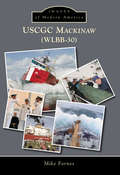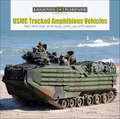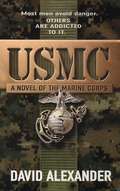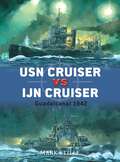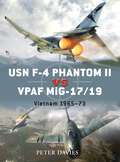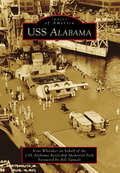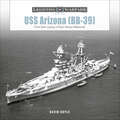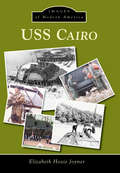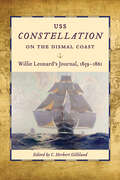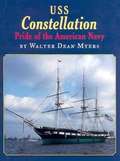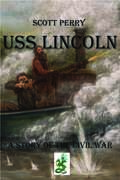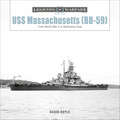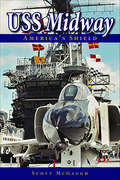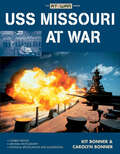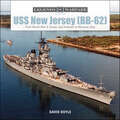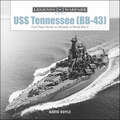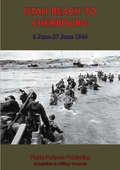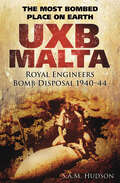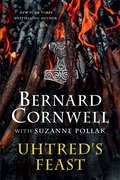- Table View
- List View
USCGC Mackinaw WLBB-30 (Images of Modern America)
by Mike FornesJune 10, 2006, marked the beginning of a new era. In a one-of-a-kind ceremony, the original U.S. Coast Guard cutter Mackinaw was decommissioned, followed by the commissioning of the new Great Lakes icebreaker that carries the same name. The old cutter's legacy would be carried through to the new ship's multi-mission capabilities of ice breaking, buoy tending, search and rescue, oil-spill response, and maritime homeland security. The new Mackinaw's sophisticated propulsion package, computer-based navigation and steering, and state-of-the-art dynamic positioning system bring new technology to its mission as "Guardian of the Great Lakes."
USMC Tracked Amphibious Vehicles: T46E1/M76 Otter, M116 Husky, LVTP5, and LVTP7/AAV7A1
by David DoyleThe specific mission of the Marine Corps has led to the development of many unusual and innovative vehicles, amphibious landing craft in particular.
USMC: A Novel of the Marine Corps
by David Stuart AlexanderU.S. Marine Colonel David Saxon has finished five months of bureaucratic hell at the Pentagon. The confines of his office had turned Saxon into a pent-up, caged beast, until he got what he wanted--a mission back to the danger zone...<P><P> Marine Colonel David Saxon's "Big Mean One" Special Ops team is being airlifted to extract hostages seized onboard an ocean liner by the infamous terrorist, Carlos Evangelista. It's a daring mid-sea rescue, one certain to cause heavy casualties. But the "Evangelist" has more in mind than slaughtering innocent civilians. A neo-Soviet plot plans to kill Libya's Kaddafi--so that a new Libyan strongman will welcome placement of Soviet missiles for a nuclear strike against the U.S. Sixth Fleet, on maneuvers in the Gulf of Sidara. To the neo-Soviet leadership and the "Evangelist," it's just the first round in a world-dominating game of nuclear brinkmanship. But to Saxon's team, it's the last round of a game with only once acceptable outcome--the obliteration of America's enemies...
USN Carriers vs IJN Carriers
by Ian Palmer Mark StilleThe Imperial Japanese Navy was a pioneer in naval aviation, having commissioned the world's first carrier, which was used against the US fleet at Pearl Harbor. The Americans followed suit, initiating huge aircraft carrier development programs. As the Pacific war escalated into the largest naval conflict in history, the role of the carrier became the linchpin of American and Japanese naval strategy as these rival vessels found themselves locked in a struggle for dominance of this critical theater of war. This book provides an analysis of the variety of weaponry available to the rival carriers, including the powerful shipborne guns and embarked aircraft. Study the design and development of these revolutionary ships, discover the pioneering tactics that were used to ensure victory and "live" the experiences of the rival airmen and gun crews as they battled for victory in a duel of skill, tenacity and guts.
USN Cruiser vs IJN Cruiser
by Paul Wright Mark StilleAlthough the war in the Pacific is usually considered a carrier war, it was the cruisers that dominated the early fighting. This thrilling duel presents the cruiser clashes during the crucial battles for Guadacanal in 1942, highlighting the Battle of Savo Island on the August 9 and the Battle of Cape Esperance October 11-12th , 1942. The first was an overwhelming Japanese victory that resulted in the loss of four Allied cruisers. However, in the latter, the Americans managed to successfully turn the tables despite the fact that the was fought through the night under dangerous conditions. This book presents a side-by-side view of the design and development of the opposing weapons systems, illustrated with newly commissioned digital artwork. It uses first-hand accounts to bring the desperate battles to life and explain why the American forces suffered early on, but eventually had their revenge.From the Trade Paperback edition.
USN Destroyer vs IJN Destroyer
by Mark StilleThis book will cover the fierce night naval battles fought after Guadalcanal between the US Navy and the Imperial Japanese Navy during late 1943 as the Allies advanced slowly up the Solomons Islands toward the major Japanese naval base at Rabaul. During this period, several vicious actions were fought around the American beachheads on the islands of New Georgia, Kolombangara and Vella Lavella in the central Solomons. These battles featured the most modern destroyers of both navies. Throughout most of 1942, the Imperial Navy had held a marked edge in night-fighting during the six-month long struggle for Guadalcanal. A key ingredient of these Japanese successes was their destroyer force which combined superior training and tactics with the most capable torpedo in the world, known to the Allies as the "Long Lance". Even into 1943, at the battles of Kula Gulf and Kolombangara, mixed Allied light cruiser/destroyer forces were roughly handled by Japanese destroyers. After these battles, the Americans decided to stop chasing Japanese destroyers with cruisers so the remainder of the battles in 1943 (with one exception) were classic destroyer duels. The Americans still enjoyed the technical edge provided to them by radar, and now added new, more aggressive tactics. After four more destroyer duels during the second half of 1943, the final result was the defeat of the Imperial Navy's finely trained destroyer force and the demonstration that the Japanese were unable to stop the Allies' advance.From the Trade Paperback edition.
USN F-4 Phantom II vs VPAF MiG-17/19
by Jim Laurier Peter DaviesThe Vietnam War placed unexpected demands upon American military forces and equipment.The principal US naval fighter, the McDonnell F-4 Phantom, had originally been designed to defend the Fleet from air attack at long range. However, its tremendous power and bomb-carrying capacity made it an obvious candidate for the attack mission in Vietnam from 1965 onwards. Its opponent was the MiG-17, a direct descendant of the MiG-15, which had given USAF Sabre jets a hard fight in the Korean War. This book brings to life their dangerous duels and includes detailed cockpit views and other specially commissioned artwork to highlight the benefits and shortcomings of each plane type. It was in the skies over Vietnam that many of the techniques of air combat evolved as pilots learned how to use and to defeat supersonic fighters for the first time.
USS Alabama (Images of America)
by Kent Whitaker USS Alabama Battleship Memorial Park Bill TunnellPowerful: this single word aptly describes a naval vessel known as a battleship. The USS Alabama (BB-60) was the last of four South Dakota-class battleships built for World War II. She is well armored and designed to survive an attack while continuing to fight. Her main battery, known as "Big Guns," consisted of nine 16-inch guns; each could launch a projectile weighing as much as a small car that could hit a target 21 miles away. Her crew numbered 2,332 men, none of whom were lost to enemy fire, earning her the nickname "Lucky A." She served as more than just a battleship: she carried troops, supplies, and seaplanes and served in the Pacific and Atlantic; her doctors treated patients from other ships; she was the wartime home for a major-league ballplayer; the movie setting for Hollywood films; and she traveled home to the state of Alabama with the help of schoolchildren.
USS Arizona (BB-39): From Keel Laying to Pearl Harbor Memorial
by David DoyleA battleship of the Pennsylvania class, USS Arizona is most famous for her disastrous loss, along with over 1,000 of her men, during the surprise attack at Pearl Harbor. Armed with 12 14-inch guns, and numerous smaller weapons, Arizona was one of the most powerful warships in the world when commissioned in 1917. This volume illustrates the modifications and improvements made to the ship during her service, and her subsequent loss and partial salvage. Today the battleship remains on the bottom of Pearl Harbor, spanned by a memorial to the sacrifice of her men. Through carefully researched archival documents and photographs, author David Doyle has constructed a pictorial history of this warship and the men who crewed her, featuring more than 300 photographs.
USS Bacalao
by J. T. McDaniel Franco G. RovedoJ.T. McDaniel assume o comando com a mão firme de um mestre em sua arte, criando uma representação precisa e fascinante da vida diária a bordo de um submarino de ataque na década de 1940. Do estaleiro do construtor em Connecticut, aos combates velozes no teatro do Pacífico, ao coração trovejante de profundidades explosivas, cada detalhe soa com autenticidade. McDaniel escreve com a precisão técnica de Tom Clancy, o ritmo de Michael DiMercurio e a compreensão humana de Edward L. Beach. Um leitor simplesmente não pode querer mais. O USS Bacalao é a história de um submarino da frota americana da classe Gato desde o pátio da Electric Boat Company na cidade de Groton de pré-guerra, em Connecticut, passando pelos primeiros treinamentos, presenciando o ataque japonês a Pearl Harbor, e atingindo o coração do Império Japonês. De Pearl Harbor a Fremantle, o pequeno barco e sua corajosa tripulação atacam um inimigo determinado e enfrentam a sua própria burocracia para levar a guerra ao inimigo. E, apesar de tudo, Lawrence Miller está lá, subindo lentamente a partir do quarto na lista de oficiais do barco, partindo para uma excursão no comando de um antigo submarino no Alasca e finalmente retornando a Bacalao como seu último oficial comandante. Uma aventura emocionante e verdadeira que encanta aqueles que admiram o mar e seus personagens.
USS Cairo: History And Artifacts Of A Civil War Gunboat (Images of Modern America)
by Elizabeth Hoxie JoynerArmed with a simple pocket compass, a small boat, and an intense desire to find the USS Cairo, three men--Edwin C. Bearss, Warren Grabau, and Max Don Jacks--set out on the Yazoo River on a cool autumn afternoon in 1956 to locate the Civil War gunboat. What they found was the discovery of a lifetime. Images of Modern America: USS Cairo features a photographic account of the discovery, raising, restoration, and preservation efforts surrounding the Cairo. One can sense the excitement and awe felt by people who witnessed the raising. Today, people from all over the world are drawn to visit this Civil War time capsule now in permanent dry dock at Vicksburg National Military Park, where commemorative events have occurred since 1980; this collection highlights a variety of these events.
USS Constellation on the Dismal Coast: Willie Leonard's Journal, 1859–1861 (Studies in Maritime History)
by C. Herbert GillilandThis seaman’s journal recounts a twenty-month voyage from Boston to the African coast to intercept slave-trading vessels as America approach the Civil War.Today the twenty-gun sloop USS Constellation is a floating museum in Baltimore Harbor; in 1859 it was an emblem of the global power of the American sailing navy. William E. Leonard served aboard the Constellation during a crucial and eventful period, chronicling it all in this remarkable journal.Sailing from Boston, the Constellation, flagship of the US African Squadron, was charged with the interception and capture of slave-trading vessels illegally en route from Africa to the Americas. During the Constellation’s deployment, the squadron captured a record number of these ships, liberating their human cargo and holding the captains and crews for criminal prosecution. At the same time, tensions at home and in the squadron increased as the American Civil War approached and erupted in April 1861.Leonard recorded not only historic events but also fascinating details about his daily life as one of the nearly four-hundred-member crew. He saw himself as not just a diarist, but a reporter, making special efforts to seek out and record information about individual crewmen, shipboard practices, recreation and daily routine—from deck swabbing and standing watch to courts martial and dramatic performances by the Constellation Dramatic Society.
USS Constellation: Pride of the American Navy
by Walter Dean MyersHistory of the USS Constellation, a medium-sized frigate used during the Revolutionary War.
USS Lincoln: A novel of the Civil War
by Scott PerryCaught behind rebel lines in New Orleans at the opening of the American Civil War, John Rawley and his crew “liberate” a ship they rechristen, the USS Lincoln and fight back towards their homes. Dubbed “river pirates” by the local authorities, Rawley and his crew pick up a small armada to disrupt river commerce and aid the Union cause. Scott Perry has crafted an accurate and detailed tale of war on the river during the American Civil War.
USS Massachusetts (BB-59): From World War II to Battleship Cove
by David DoyleThe USS Massachusetts is a fast battleship that fought in some of the key naval battles of WWII, including Casablanca, the Philippines, and Okinawa
USS Midway: America's Shield
by Scott McGaugh"As the captain of the USS Midway I was never more proud of the young men, mostly teenagers, under my command. USS Midway: America's Shield tells their story, straight from the flight deck. It's real American history everyone should know."—;Rear Adm. Riley Mixson, U.S. Navy (ret.), former captain, USS Midway"USS Midway: America's Shield carries the reader along from one great event of the latter twentieth century to another. An odyssey fueled by remarkable young men from every corner of America. An inspiration to us all!"—;Lou Reda, documentary filmmaker, History ChannelThe USS Midway first set sail in 1945 with thousands of young men on board. By the time it made its final return to port in 1992, approximately 200,000 Americans had served on the carrier. During those years, the crew—;whose average age was nineteen—;witnessed significant world affairs, such as Cold War espionage missions, an attack by an Israeli aircraft, confrontations with Mao Tse-tung, and the liberation of Kuwait.Beginning with World War II, this collection of memoirs chronicles individual accounts of sailors who served on the Midway. All of the stories offer a glimpse into the early days of the sailors' lives and detail the contributions that they made at sea. This collective biography relates their compelling tales of empowerment and optimism, while presenting America's past. One hundred pictures provide a visual reference.
USS Missouri at War (The At War Series)
by Kit Bonner Carolyn BonnerAn illustrated history of the wartime career of the USS Missouri from World War II to the Gulf War.On September 2, 1945, surrender ceremonies officially ending World War II were broadcast worldwide from the deck of the USS Missouri. The ceremony also marked the end of one of the most eventful years for any vessel in the history of warfare. USS Missouri at War chronicles the career of this mighty warship, the last battleship built by the United States.Veteran naval historian Kit Bonner describes “Mighty Mo’s” powerful strikes against Japan, its support of the Iwo Jima landings and bombardment of Okinawa, and its decisive role in the destruction of key Japanese industrial targets. That war was over, but the Missouri was not done yet; and Bonner follows her service in the Korean War, her modernization and reactivation for the 1991 Gulf War, and her final decommissioning in 1992, with eleven battle stars to her credit.For its authoritative and close-up look at the life and work of a world-class battleship, and for its insight into the history of twentieth-century naval warfare, this strikingly illustrated book is one that no naval enthusiast or military history buff will want to be without.
USS New Jersey: From World War II, Korea, and Vietnam to Museum Ship (BB-62 #5)
by David DoylePhotographic history of the design, construction, and deployment of the famed US Iowa-class battleshipChronicles New Jersey's 70+ year history with combat in WWII, Korea, Vietnam, and LebanonProfusely illustrated with scarce archival photographs from diverse collections, including previously unpublished images
USS Tennessee: From Pearl Harbor to Okinawa in World War II (BB-43 #7)
by David DoyleHistory of the design, development, and deployment of USS Tennessee, survivor of the Pearl Harbor attackChronicles the construction, launch, commissioning, and combat history of the Tennessee's 40+ year historyProfusely illustrated with scarce archival photographs from diverse collections, including previously unpublished images
UTAH BEACH TO CHERBOURG - 6-27 JUNE 1944 [Illustrated Edition]
by AnonIllustrated with over 40 photos and 15 maps of the engagement.The momentous events of the 6th of June 1944, D-Day, still resonate around the world, almost 200,000 Allied Soldiers were thrown against the Nazi dominated coast of France in a bid to free Western Europe from the Fascist grip that had held it since 1939. Although massive air and naval bombardments proceeded the landings the mission would succeed or fail based on the ground troops being able to force their way in land and allow a secure bridgehead to be formed out of enemy artillery range. However, the buildup of supplies and troops for the millions strong armies necessary to liberate Europe could not be brought through the improvised Mulberry harbour on the unprotected beaches of Normandy, a port must be taken. The troops on the far left of the line attacking the beach code-named "Utah" would be tasked not only with the initial assault of the coastline but to eventually capture Cherbourg and the Cotentin Peninsula. The fighting on D-Day on the beach was tough but successful, very since the early morning the paratroops fought in many groups some numbering a few men up to battalion size to secure the vital targets inland.The Germans were aware of the importance of the landing only gradually, but launched fierce counterattacks against the Americans coming across the flooded land inland from the beaches. The port of Cherbourg and town were heavily defended and had many difficult fortifications to be overcome, but the Americans were equal to the task and eventually captured it ensuring the supply lines for the armies that would engage and fight Hitler's legions across France, Belgium , Holland and into Germany.An excellent study of the second American Beach landing and along with its companion volume, OMAHA BEACHHEAD, provide an unparalleled record of the fighting of the American forces on D-Day and in the Bocage fighting in Normandy.
UXB Malta: The Most Bombed Place on Earth
by S A M HudsonAs the Regia Aeronautica and the Luftwaffe unleashed their full might against the island of Malta, the civilian population was in the eye of the storm. Faced with the terror of the unexploded bomb, the Maltese people looked for help to the Royal Engineers Bomb Disposal Section, who dealt with all unexploded bombs, outside of airfields and the RN dockyard, across an area the size of Greater London. Based on official wartime records and personal memoirs, the extraordinary tale unfolds of the challenges they faced — as the enemy employed every possible weapon in a relentless bombing campaign: 3,000 raids in two years. Through violent winter storms and blazing summer heat, despite interrupted sleep and meagre rations, they battled to reach, excavate and render safe thousands of unexploded bombs. Day after day, and in 1942 hour after hour — through constant air raids — they approached live bomb after live bomb, mindful that it could explode at any moment. In the words of one of their number they were ‘just doing a job’.
Uhtred's Feast: Inside the World of The Last Kingdom
by Bernard CornwellIn this engaging social history New York Times bestselling author Bernard Cornwell, “the most prolific and successful historical novelist in the world today” (Wall Street Journal), completes his epic Last Kingdom series with this companion book featuring three exclusive short stories and sixty recipes that bring Uhtred’s world to life as never before.My name is Uhtred. I am the son of Uhtred, who was the son of Uhtred and his father was also called Uhtred . . . The Last Kingdom is one of the most successful historical fiction series of our time. The novels tell the epic story of the birth of England and introduces one of the greatest ever fictional heroes: the iconic Uhtred of Bebbanburg, the Saxon-born, Norse-raised warrior and rebel. In this lively compendium, Bernard Cornwell revisits Uhtred’s realm, illuminating elements of the Anglo-Saxon world he couldn’t fully explore in his novels.Uhtred’s Feast offers rich background on the books of the Last Kingdom series, presenting a fascinating, detailed view of Anglo-Saxon life in all its splendor, danger, and beauty. With his narrative flair, Cornwell explores every aspect of this historical period, from the clothes to weapons to food, offering beautifully crafted recipes of early Anglo-Saxon fare, created by renowned UK chef Suzanne Pollak. In addition, he has written three new stories exclusive to this book that reveal the man behind the shield—Uhtred as a young boy, as Alfred’s advisor, and as prince.
Uhura's Song (Star Trek: The Original Series #21)
by Janet KaganYears ago, Lt. Uhura befriended a diplomat from Eeiauo, the land of graceful, cat-like beings. The two women exchanged songs and promised never to reveal their secret—but now, those songs may be the only hope to save the planets from a deadly epidemic.The U.S.S. Enterprise™ is orbiting Eeiauo in a desperate race to save the inhabitants before a deadly plague destroys them. Uhura's secret songs may hold the key to a cure—but the clues are veiled in layers of mystery and the inhabitants of Eeiauo aren't what they seem. But the plague is killing humans, threatening other planets—and Kirk must crack the code before the Starship Enterprise succumbs!
Ukraine 22: Ukrainian Writers Respond to War
by Mark Andryczyk'The extraordinary writers in this volume articulate the taste, the terror, and the dialect of war; they command their powers of description to face a shameless empire intent on annihilating them' Ellena SavageA selection of Ukraine's leading writers convey the reality of life within Ukraine during the first year of the invasionOn 24 February 2022, the lives of Ukrainians were devastatingly altered. Since that day, many of Ukraine's writers have attempted to fathom what is happening to them and to their country. This anthology brings together writing from inside Ukraine, by Ukrainians, available in English for the first time. Here they document everyday life, ponder the role of culture amid conflict, denounce Russian imperialism and revisit their relations with the world, especially Europe and its ideals, as they try to comprehend the horrors of war.From tearing-downs of Russia's use of culture as justification of the war to moving descriptions of nights spent sheltering in corridors, poignant snatched moments with a husband on his single night away from the army, to descriptions of the eerie weather in the months leading up to the invasion, as if nature was trying to warn Ukraine, these essays reveal the texture, rawness and reality of life in Ukraine under war as never before.
Ukraine, War, Love: A Donetsk Diary (Harvard Library of Ukrainian Literature #7)
by Olena StiazhkinaIn Ukraine, War, Love, Olena Stiazhkina depicts day-to-day developments in and around her beloved hometown Donetsk during Russia’s 2014 invasion and occupation of the Ukrainian city. An award-winning fiction writer, Stiazhkina chronicles an increasingly harrowing series of events with sarcasm, anger, humor, and love.The diary opens on March 2, 2014, as the first wave of pro-Russian protest washes over eastern Ukraine in the wake of Euromaidan, the Revolution of Dignity, and it closes on August 18, 2014, the day a convoy of civilian Ukrainian refugees is deliberately slaughtered by Russian forces. Early on, Stiazhkina is captured by pro-Russian forces while she browses for books but is freed when one of her captors turns out to be a former student. Vignettes from her personal life intermingle with current events, and she examines ordinary people in extraordinary circumstances. We walk with local dogs and their owners; we meet a formidable apartment building manager who shames occupiers and dismantles their artillery from the roof of her building; we follow a family evacuated to Kyiv whose young son builds checkpoints out of Legos. Olena Stiazhkina’s Ukraine, War, Love: A Donetsk Diary is a fierce love letter to her country, her city, and her people.
